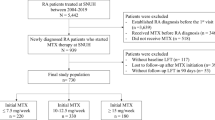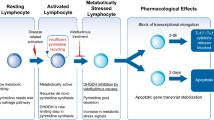Abstract
Objective: Leflunomide is a novel disease modifying antirheumatic drug (DMARD). Because of reports on possible hepatotoxicity and adaptations in the recommendations for monitoring liver function during leflunomide treatment, we conducted a study to evaluate the incidence and severity of hepatotoxicity.
Methods: We included consecutive rheumatoid arthritis patients starting treatment with leflunomide in the region of Friesland (The Netherlands) between January 2000 and January 2002. During follow-up patient characteristics, disease characteristics, and clinical and laboratory data on liver functions were registered. Severity of hepatotoxicity was categorised using the National Cancer Institute Common Toxicity Criteria, as moderate (grade 2), severe (grade 3) or life threatening (grade 4).
Results: One hundred and one patients were followed for a median period of 10 months (range 0.5–12). Grade 2 or 3 elevations in any liver function blood test were recorded in a total of nine patients (8.9%). No grade 4 elevations were recorded. Four patients (4%) showed grade 2–3 aminotransferase elevations. Due to grade 2 hepatotoxicity one patient (1%) was withdrawn from leflunomide treatment, and one patient continued leflunomide at a reduced dose. In eight of nine patients with grade 2–3 liver function blood tests, these elevated liver function tests occurred within 6 months after starting leflunomide. None of the patients with grade 2 or 3 toxicity had a history of hepatic disease, eight patients concomitantly used potential hepatotoxic co-medication. Eight (8%) patients used leflunomide in combination with methotrexate, and one of these patients developed hepatotoxicity. No clinical signs of serious hepatotoxicity were recorded during follow-up.
Discussion: In 8.9% of the patients, grade 2 or 3 hepatotoxicity was recorded within the first year after the start of leflunomide therapy based on liver enzyme determinations. In the majority of the patients liver enzyme elevations occurred within the first 6 months of therapy and resolved during continued follow-up. None of the patients showed clinical signs of hepatotoxicity.
Conclusion: Under continued monitoring of liver functions hepatotoxicity during leflunomide use does not seem to be a major problem in our population.



Similar content being viewed by others
References
Emery P, Breedveld FC, Lemmel EM, et al. A comparison of the efficacy and safety of leflunomide and methotrexate for the treatment of rheumatoid arthritis. Rheumatology 2000; 39: 655–65
Strand V, Cohen S, Schiff M, et al. Treatment of active rheumatoid arthritis with lefunomide compared with placebo and methotrexate. Arch Intern Med 1999; 159: 2542–50
Smolen JS, Kalden JR, Scott DL, et al. Efficacy and safety of leflunomide compared with placebo and sulfasalazine in active rheumatoid arthritis: a double-blind, randomised, multicentre trial. European Leflunomide Study Group. Lancet 1999; 353: 259–66
Prevoo ML, van’t Hof MA, Kuper HH, et al. Modified disease activity scores that include twenty-eight-joint counts. Development and validation in a prospective longitudinal study of patients with rheumatoid arthritis. Arthritis Rheum 1995; 38(1): 44–8
Green RM, Flamm S. AGA technical review on the evaluation of liver chemistry tests. Gastroenterology 2002; 123: 1367–84
Dukes MNG, editor. Meyler’s side effects of drugs: an encyclopedia of adverse drug reactions. 13th ed. Amsterdam: Elsevier, 1996
Cannon GW, Schiff M, Strand V, et al. Hepatic adverse events and other toxicity during treatment with leflunomide (LEF), methotrexate (MTX), other disease modifying anti-rheumatic drugs (DMARDs), and combination DMARD therapy: comparison to NSAIDs alone and adjustment for comorbidities [abstract]. Arthritis Rheum 2002; 46Suppl. 1: S166
Wolfe F. Low rates of serious liver toxicity to leflunomide (LEF) and methotrexate (MTX): a longitudinal surveillance study of 14,997 LEF and MTX exposures in RA [abstract]. Arthritis Rheum 2002; 46Suppl. 1: S375
Osiri M, Shea B, Robinson V, et al. Leflunomide for the treatment of rheumatoid arthritis: a systematic review and metaanalysis. J Rheumatol 2003; 30: 1182–90
Scott DL, Smolen JS, Kalden JR, et al. for the European Leflunomide Study Group. Treatment of active rheumatoid arthritis with leflunomide: two year follow up of a double blind, placebo controlled trial versus sulfasalazine. Ann Rheum Dis 2001; 60: 913–23
Cohen S, Cannon GW, Schiff M, et al. Two-year, blinded, randomized, controlled trial of treatment of active rheumatoid arthritis with leflunomide compared with methotrexate. Arthritis Rheum 2001; 44: 1984–92
Weinblatt ME, Kremer JM, Coblyn JS, et al. Pharmacokinetics, safety, and efficacy of combination treatment with methotrexate and leflunomide in patients with active rheumatoid arthritis. Arthritis Rheum 1999; 42: 1322–8
Kremer JM, Genovese MC, Cannon GW, et al. Concomitant leflunomide therapy in patients with active rheumatoid arthritis despite stable doses of methotrexate. Ann Intern Med 2002; 137: 726–33
Hoi A, Littlejohn GO. Aminotransferase levels during treatment of rheumatoid arthritis with leflunomide in clinical practice [letter]. Ann Rheum Dis 2003; 62: 379
Breedveld FC. Is there a place for leflunomide in the treatment of rheumatoid arthritis? Lancet 2001; 358: 1198–2000
Acknowledgements
The authors have received no sources of funding that were used to assist in conducting this study.
The authors have no potential conflicts of interest that may be directly relevant to the contents of the study.
Author information
Authors and Affiliations
Corresponding author
Rights and permissions
About this article
Cite this article
van Roon, E.N., Jansen, T.L., Houtman, N.M. et al. Leflunomide for the Treatment of Rheumatoid Arthritis in Clinical Practice. Drug-Safety 27, 345–352 (2004). https://doi.org/10.2165/00002018-200427050-00006
Published:
Issue Date:
DOI: https://doi.org/10.2165/00002018-200427050-00006




